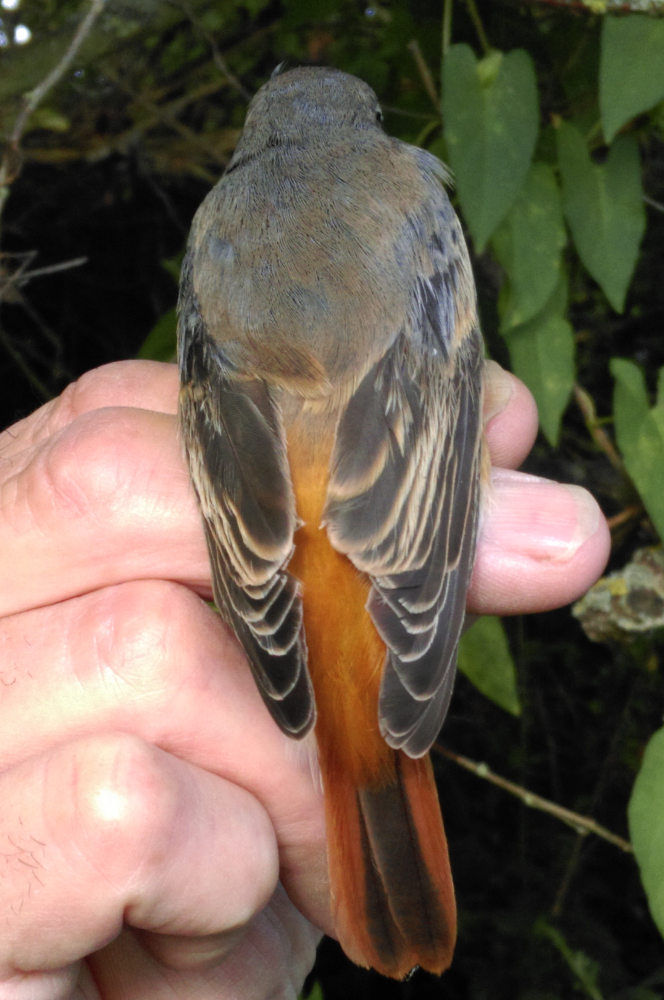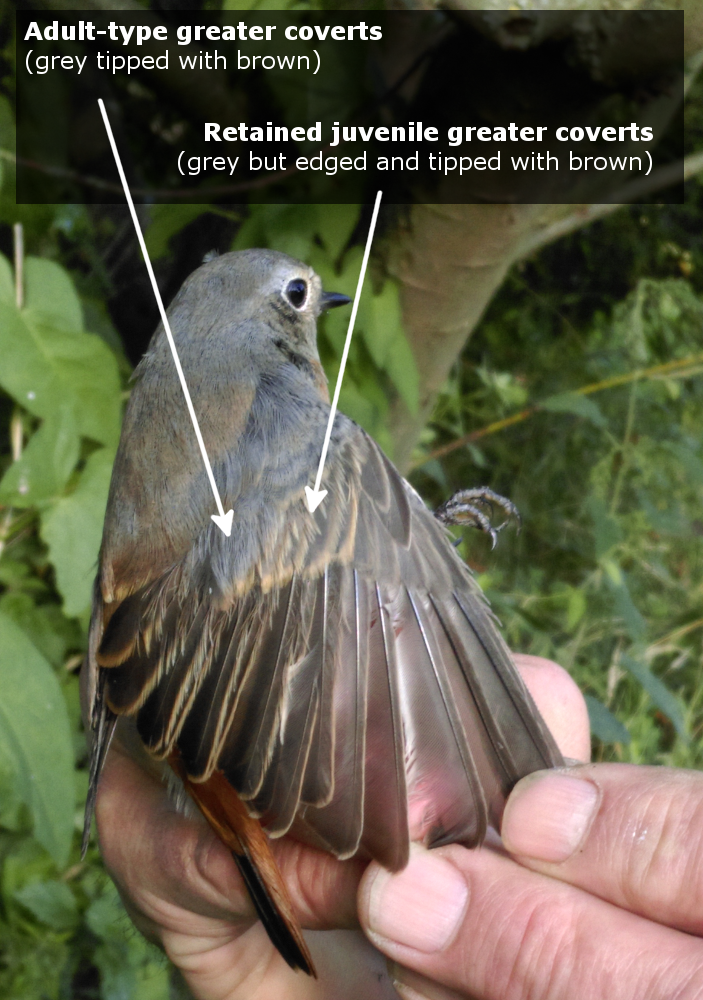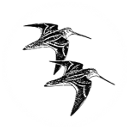
Jan Swan was lucky enough to catch our best bird of the autumn so far. Here she recounts the experience and tells how it was identified, aged and sexed.
A nice Start at the end
Picture the scene; daybreak on a warm August bank holiday Monday and I'm putting up the eight Constant Effort Site (CES) nets at our reed bed site on the reserve. This is the twelfth and final official CES visit for 2016 and one which always brings a mixture of feelings. Firstly, sadness that this year's summer visitors and migrant fledglings are now starting to make their way to their wintering grounds. Secondly, sheer relief that it's all over for another year; the galloping vegetation is a beast to maintain and it has its own humid micro-climate which the mozzies and horse flies just love. It's also prone to by-catches of Migrant Hawker dragonflies. (These are always a challenge to extract from a mist net but to add a bit of complexity to today's proceedings I had a mating pair, which I'm pleased to say flew off unharmed and still going about their 'business'!!) Finally, there's the excitement of what the autumn might bring.
The first check of the nets is pretty quiet, as is normal for this site at this time of year; just 13 birds in total and aside from a Wren the rest are the normal warbler species for the site (Willow, Reed, Garden, Sedge and Whitethroat). By the second round though things start to pick up and I had extracted 20 or so birds from the first two net rides alone, mainly Reed and Sedge Warblers but also Chiffchaff, Blackcap and Blackbird.
Methodically clearing each net ride, I was thinking about a conversation I'd recently had with one of the other ringers. 'Good birds' was the subject but more specifically when we'd last had a good bird which no-one knew was around until it turned up in a net. Several suggestions were made but we both agreed the Wood Warbler back in 2010 was it; a fantastic bird!
Back to today and on arriving at the fifth and final net ride I made a quick scan of the nets, and something unusual caught my eye. There, upside down in the top panel, was an unfamiliar bird. For the non-ringers reading this, even extremely common birds can look 'unusual' upside down. I once saw a bird in a similar position; it looked so different to anything I'd seen before, mainly because the position exposed feather colours I hadn't noticed in the field. Thinking it was going to be something a bit different, it was a bit of let-down when I realised it was 'just' a female Chaffinch. Anyway, I digress. Again. I assessed the other birds waiting to be extracted but there was nothing which needed to take priority so I approached the bird in front of me and could see there was a lot of orange both in the tail and on the breast. Then I saw the unmistakeable dark central tail feathers and a very large smile spread across my face and I said, out loud although no-one else was around, "Excellent. Redstart."
This transpired to be only the group's 14th Redstart, which has been a very sporadic species for Rye Meads, to say the least. The table opposite shows the split of age/sex of these encounters across spring and autumn.
Year Spring Autumn
1961 Adult female
1964 Juvenile (unsexed)
1981 Second calendar year male
1984 Second calendar year male Juvenile female
1985 Adult female
1985 Juvenile male
1992 Juvenile male
2000 Juvenile female
2001 Adult female
2004 2 x adult female
2010 Juvenile female
2016 Juvenile male
Once safely removed from the net and secured in a bird bag I extracted the remaining birds, checked the nets once again on the return journey to my ringing base, near the Draper hide, and phoned Gary Gardiner, one of our ringers, to alert him and others on site about my catch and to find out if anyone had a camera on them. Toby Spall, another of our ringers, appeared at that moment, having just been to ‘twitch’ the two Little Stints which had been gracing the scrape for the last couple of days. Delighted at seeing the Redstart, he offered up that it was a juvenile male.
The grey on the head, wing coverts and back as well as the beginnings of a white forehead and black chin, the latter unfortunately not overly clear in the left-hand photo, were the key characteristics which told us this was a male.



As for ageing the bird, for a lot of species we’re able to narrow this down by looking at what kind of moult it’s done or is doing. The Redstart is one of those species and the break in colour of the greater covert edges indicates that this bird has gone through a partial post-juvenile moult where it’s replaced the two innermost greater coverts with adult-type feathers but has retained some of its juvenile greater coverts.
If this bird is retrapped by a ringer in the UK next Spring, as long as those covert edges haven’t significantly worn away, they will be able to identify it as a second calendar year bird on just those retained juvenile feathers. A simple but generally effective rule of thumb.
After ringing the bird and with the age and sex noted I take the normal biometric measurements of wing length; this is 80mm so in the upper part of the 70-84mm range for this species. I also weigh it and it comes in at a healthy 14.6g; the average is 14g. As it’s a migratory species (it winters in Africa) we also check for fat deposits at this time of year. This is done simply by blowing the feathers aside under the chin, on the abdomen and the flanks. This bird had none but if any fat had been put down it would’ve shown up as yellow under the skin and on a heavy bird this would also start to bulge out, much like me when I eat too many takeaways!
The whole ringing process takes no more than a few minutes and after a quick photo-call to procure the above record shots, the bird is put safely and securely back in the bird bag and Toby takes it to the reserve centre, which had by that time just opened, to show to staff and any early visitors.
Given how infrequently we see Redstarts at Rye Meads, let alone catch them, I feel very privileged not only to have ringed this one but also the last one, in 2010, when I was a trainee. Whilst not quite in the same league as a Wood Warbler, it was one of those rare ‘didn’t know it was around until it turned up in a net’ occasions and an absolute bonus for the final day of this year’s CES season.
Can’t wait for next year’s CES now; I wonder what it will bring...
